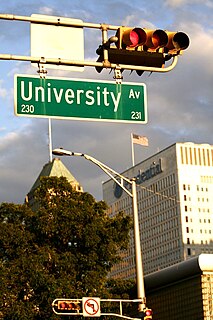
University Heights is a neighborhood in Newark in Essex County, New Jersey, United States. It is so named because of the location of four academic institutions within its boundaries — Rutgers University, the New Jersey Institute of Technology (NJIT), the New Jersey Medical School (Rutgers), and Essex County College. In total, the schools enroll approximately 35,000 degree-seeking students.

Brick Church is a New Jersey Transit station in East Orange, Essex County, New Jersey, United States, along the Morris and Essex Line. Service is available from this station east to Hoboken Terminal, New York Penn Station and west to Dover and Hackettstown.

Orange is a New Jersey Transit station in Orange, Essex County, New Jersey, United States, along the Morris & Essex Lines. Eastbound service is available via the Kearny Connection to Secaucus Junction and Penn Station in Midtown Manhattan and there is also service to Hoboken Terminal.

All Saints' Memorial Church is a small stone Gothic-style Episcopal church built in 1864 by Richard Upjohn in Navesink, New Jersey. A National Historic Landmark, the church complex, which includes the rectory, stable, and carriage house, is a well-preserved example of the late work of Upjohn.

Grace Church in Newark (Episcopal) is an active and historic Episcopal Church in the Diocese of Newark. It is located on Newark, New Jersey's Broad Street where it has stood since 1837. Grace is a traditional church that worships in the Catholic tradition. Grace is notable for its architecture, music, and as the birthplace of the tune "America the Beautiful".
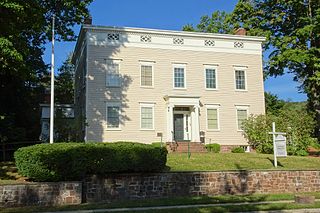
The Israel Crane House is a federal-style home located at 110 Orange Road in Montclair, Essex County, New Jersey. The house has had a rich history and was added to the National Register of Historic Places on March 14, 1973 for its significance in architecture, conservation, and industry.
William Halsey Wood was an American architect.

St. Stephen's Episcopal Church, in Beverly, Burlington County, New Jersey, United States, is located on the corner of Warren and Wilmerton streets in Beverly. While the St. Stephen's community worshipped at the site beginning in 1837, the current church building was consecrated in 1855 and the rector presently serving the congregation is Fr. Robert Legnani.
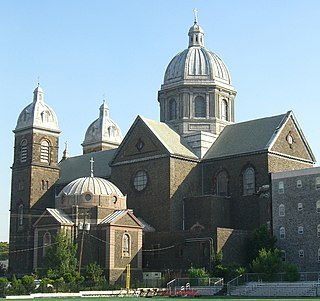
The Monastery and Church of Saint Michael the Archangel, known locally as Saint Michael's Monastery Church, is a state and national historic place in Union City, Hudson County, New Jersey, United States. Formally opened in 1869 and completed in 1875, the grounds of the complex are bounded West Street and Summit Avenue between 18th and 21st Streets. The small street leading to its front entrance from the east is called Monastery Place. At one time the largest Roman Catholic church in Hudson County, it has since become home to a Presbyterian congregation while part of the grounds are used for housing and education.

Bethany Baptist Church is a historic church at 117 W. Market Street in Newark, Essex County, New Jersey, United States.
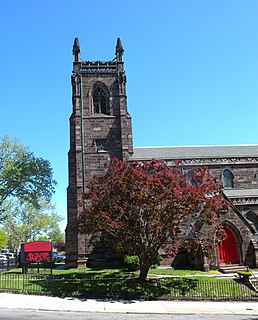
St. James' A.M.E. Church is a historic church located at High and Court Streets in Newark, New Jersey. Built in 1850 by architect John Welch and dedicated in 1854, it was originally called the High Street Presbyterian Church until 1926, when it was briefly disbanded. It was re-established as Bethel AME Church before being renamed Saint James' AME Church.

St. John's Church is a historic Roman Catholic parish church located within the Archdiocese of Newark at 22-26 Mulberry Street in Newark, Essex County, New Jersey, United States. St. John's Church is the state's third-oldest Catholic church.

Trinity & St. Philip's Cathedral is a historic church at Broad and Rector Streets in Newark, Essex County, New Jersey, United States. It is the seat of the Episcopal Diocese of Newark.

Trinity Church is a historic church on the northwest corner of Church Street and King's Highway in Swedesboro, in Gloucester County, New Jersey, United States.

The old Essex County Jail is located in the University Heights section of Newark, Essex County, New Jersey, United States. The jail is Essex County's oldest public building and a national landmark of value for its architectural and social history. The complex consists of about 20 structures of various size, age, and function ranging in date from the 1830s to 1930s. Collectively, they represent the evolution of American prison history over 100 years. For the quality of its architecture, its social history, and its links to the 1967 Newark Riots, this jail was added to the National Register of Historic Places on September 3, 1991.

The New Jersey Bell Headquarters Building is located in Newark, Essex County, New Jersey, United States. The building was built in 1929 by the New Jersey Bell Telephone Company and was added to the National Register of Historic Places on September 21, 2005. The art deco building was designed by Ralph Thomas Walker of the architectural firm Voorhees, Gmelin, and Walker. The buff brick and sandstone façade is decorated with pilasters created by sculptor Edward McCartan. Since the building's opening, soft orange lights have bathed its upper floors at night. The building is 20 stories and 275 ft (84 m) tall. The building later became headquarters for Verizon New Jersey, Inc.

St. Barnabas' Episcopal Church, is located in Newark, Essex County, New Jersey, United States. The building was built in 1864 and was added to the National Register of Historic Places on October 18, 1972.
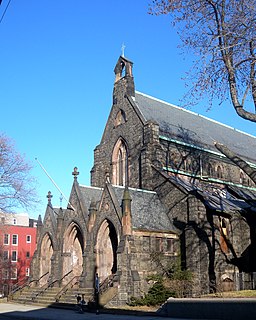
Saint John's Episcopal Church in Jersey City, New Jersey is located on Summit Avenue in Bergen Hill. Owned by the Episcopal Diocese of Newark, it is considered a masterwork of 19th-century ecclesiastical architecture. The building, which has fallen into disrepair, became a municipal landmark in 2013.

Christ Church, Newton, also known as Christ Episcopal Church, is a Christian house of worship located on the corner of Church Street and Main Street in Newton, New Jersey. It is a parish overseen by the Episcopal Diocese of Newark, a diocese of the Episcopal Church in the United States of America. The congregation first met on 28 December 1769 and was granted a charter by New Jersey's last Royal Governor William Franklin on behalf of Britain's King George III. Christ Church is the oldest church in Newton and the third oldest parish in the Diocese of Newark.

First Methodist Episcopal Church, also known as United Methodist Church, is a historic church at 116 East Washington Avenue in Washington, Warren County, New Jersey. It was built from 1895 to 1898 with a Richardsonian Romanesque architectural style. The church was added to the National Register of Historic Places for its significance in architecture on July 17, 2017. The parsonage, built 1892, is also included in the listing.






















